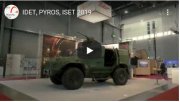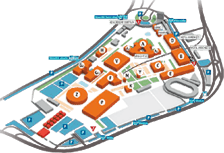IDET
24.-26.5. 2023
International Defence and Security Technologies Fair

evolving systems consulting s.r.o.
an esc Aerospace Company
Avionics 3rd generation
 esc Aerospace engineers have designed and produced a control system for the new generation of Czech RPAS/UAS, used as aerial targets. This includes the on-board electronic systems and embedded software
esc Aerospace engineers have designed and produced a control system for the new generation of Czech RPAS/UAS, used as aerial targets. This includes the on-board electronic systems and embedded software
The 3rd generation avionics can be part of following unmanned systems:
- HAES 90 – mini unmanned reconnaissance platform "Electric ray"
- HAES 400 – autonomous aerial target system (electrical engine)
- HAES 400 JET – autonomous aerial target system (jet engine)
- HAES Scanner – reconnaissance and surveillance system
The 3rd generation avionics are fully modernized a miniaturized version of the 2nd generation avionics, which have been verified and succesfully applied. On-board avionics 3rd generation are highly integrated, much lighter and consist of upgraded components.
Deployment on additional UAV platforms
 In addition to the highest platforms listed above, the 3rd generation avionics have been deployed on the following systems:
In addition to the highest platforms listed above, the 3rd generation avionics have been deployed on the following systems:
- Diamond was designed to be a high speed UAV target travelling up to 510 km/h powered by a small turbine. This UAV can fly up to 20 minutes. Like the HAES platforms it is composed of composite materials to be as efficient as possible. The UAV is designed to take-off and land on a runway.
- Celia was designed to be a highly manoeuvrable UAV target with a large radar cross section, with a 30 minutes endurance. Because of its larger size it can host a number of payloads and was designed to be recovered with a parachute system.
Space qualified flight SW for space instrumentation, satellites and rocket technologies
 esc Aerospace provides on-board SW development for satellite instruments, satellite platforms and launcher technologies. All products are ECSS (European Cooperation for Space Standardization) compliant. esc Aerospace has been providing products and services to the European space industry since 2005.
esc Aerospace provides on-board SW development for satellite instruments, satellite platforms and launcher technologies. All products are ECSS (European Cooperation for Space Standardization) compliant. esc Aerospace has been providing products and services to the European space industry since 2005.
Payload – Ionizing radiation hardened detector
 Aerial monitoring is one of the methods used in the event of a radiological accident, where fast indicative mapping of radiation levels of the affected area and information distribution of the situation are critical (primary data are collected and calculated using propagation models and real weather conditions). Spectrometric measurements can find surface activity of radio nuclides on the ground. Aerial monitoring is performed by a RPAS/UAS/helicopter flying up to an altitude of about 100 m above the ground on a predetermined (waypoint selected) route. During aerial monitoring continuous sampling is carried out measuring the photon dose equivalent (PFDE), which is automatically recalculated to 1 m height above the ground. The payload is able to distinguish the individual types of ionizing radiation without being equipped with a special set of sensors for particular types of ionizing radiation. Multiple payloads can be deployed in the exposed area to create a distributed system for detection of ionizing radiation. The radio communication among the units and their base station will be established in an autonomously created network topology; the units will transfer the location of the system and the spectrum of detected ionizing and non-ionizing radiation to a remote data acquisition system. Various other mobile platforms, not only RPAS/UAVs can be equipped with this payload for on-ground direct monitoring.
Aerial monitoring is one of the methods used in the event of a radiological accident, where fast indicative mapping of radiation levels of the affected area and information distribution of the situation are critical (primary data are collected and calculated using propagation models and real weather conditions). Spectrometric measurements can find surface activity of radio nuclides on the ground. Aerial monitoring is performed by a RPAS/UAS/helicopter flying up to an altitude of about 100 m above the ground on a predetermined (waypoint selected) route. During aerial monitoring continuous sampling is carried out measuring the photon dose equivalent (PFDE), which is automatically recalculated to 1 m height above the ground. The payload is able to distinguish the individual types of ionizing radiation without being equipped with a special set of sensors for particular types of ionizing radiation. Multiple payloads can be deployed in the exposed area to create a distributed system for detection of ionizing radiation. The radio communication among the units and their base station will be established in an autonomously created network topology; the units will transfer the location of the system and the spectrum of detected ionizing and non-ionizing radiation to a remote data acquisition system. Various other mobile platforms, not only RPAS/UAVs can be equipped with this payload for on-ground direct monitoring.
Deployment on various RPAS/UAS platforms
 The Ionizing radiation hardened detector can be deployed on fast moving RPAS/UAS systems in addition to common quadrocopters and manned vehicles such as helicopters and turboprops. The detector is being customized to be hosted on the following high-speed RPAS/UAS platforms:
The Ionizing radiation hardened detector can be deployed on fast moving RPAS/UAS systems in addition to common quadrocopters and manned vehicles such as helicopters and turboprops. The detector is being customized to be hosted on the following high-speed RPAS/UAS platforms:
- HAES 400 and HAES 400 JET platforms are multi-purpose UAV platforms that can host a large number of payloads for both target training and data gathering purposes. Its long range communications along with a 3000 m operational ceiling make it a versatile platform to deploy such a sensor if the HAES will not be used as a target.
- Diamond was designed to be a high speed UAV target travelling up to 510 km/h powered by a small turbine. This UAV can fly up to 20 minutes. Like the HAES platforms it is composed of composite materials to be as efficient as possible. The UAV is designed to take-off and land on a runway.
- Celia was designed to be a highly manoeuvrable UAV target with a large radar cross section, with a 30 minutes endurance. Its larger size can host a number of payloads and was designed to be recovered with a parachute system.
HAES 400 and HAES 400 JET Aerial Targets
 The HAES 400 is an autonomous aerial target used to provide a threat-representative target drone to support Ground-to-Air Weapon System evaluations, testing and training programs.
The HAES 400 is an autonomous aerial target used to provide a threat-representative target drone to support Ground-to-Air Weapon System evaluations, testing and training programs.
Features
The HAES 400, manufactured by HAES Group (a joint venture of the companies Hacker Model Production and esc Aerospace), is constructed of carbon fibre and epoxy-based materials.
The HAES 400 is capable of speeds from 80 km/h (49 mph) to 500 km/h (305 mph) true airspeed at sea level. The drone can achieve flight altitudes from 30 m (100 ft) above ground level to 3,000 m (10,000 ft) mean sea level.
Manoeuvres include G-turns up to 20 Gs, and other aerial acrobatic turns. The drone is launched from a rail system. The drone can land onto an organized terrain or by using a parachute recovery system. Recovered targets are tested, repaired if needed and reused. The HAES 400 can carry a full range of various payloads.
A realistically moving aerial target provides efficient shooting practice and combat firing for anti-aircraft missile systems SHORAD/VSHORAD, thus improving the quality and efficiency of the gunner/operator training.
esc Aerospace offers
Full service of target technologies – for both HAES 400 and HAES 400 JET – for MANPADS and air defence:
- Logistic support for targets, launch systems and a ground control segment.
- Programming of target defensive manoeuvres (manoeuvre against a fire control, missile manoeuvres, etc.) according to the gunner/operator requirements.
- IT support of planned shooting tasks according to selected maps.
- Utilization for a complete review of a shooting cycle – reconnaissance sensors target capture, C2I processing and evaluation, handover of targets to a shooting system and a destruction of a target.
- Replay of a flight trajectory according to selected tasks with a guaranteed accuracy, with a record of a trajectory in real time, with a possibility to evaluate shooting results.
- Professional advice and consultation – possibility to train operators, maintenance and inspection personnel.
Concurrently with
You might be interested in
Highlights from companies







